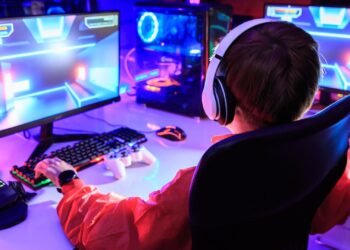A player’s job in most video games is to navigate the environment using their hands and fingers. This skill falls strongly under the umbrella of gross motor skills, as it requires a great deal of coordination between muscle groups, visual input, and cognitive process.
Fine motor skills are the ability to use your hands with dexterity. They can be used for a variety of tasks, such as writing and drawing. Gross motor skills are the ability to move large muscle groups quickly.
Catching a ball, balancing, climbing, jumping on a trampoline, playing tag, and running races are just a few examples. And that’s on top of a baby’s rapid gross motor development in the first 16 months of life: rolling over, sitting up, crawling, and walking!
Which of the following is the finest illustration of a gross motor skill?
Standing, walking, moving up and down stairs, jogging, swimming, and other activities that engage the major muscles of the arms, legs, and torso are examples of gross motor abilities. These are mostly developed throughout infancy via play and physical exercise.
In the same way, which of the following are examples of fine motor skills? When youngsters learn to utilize their tiny muscles, such as those in their hands, fingers, and wrists, they develop fine motor abilities. Writing, grasping tiny objects, buttoning garments, flipping pages, eating, cutting with scissors, and using computer keyboards all need fine motor abilities.
Which of the following is a gross motor skill, as well?
From birth until the age of five, gross motor abilities are developed. The bigger muscles in the arms, legs, and torso are used in gross motor abilities. Walking, running, throwing, lifting, kicking, and other gross motor actions are examples. Body awareness, response quickness, balance, and strength are all related to these talents.
Which of the following is a quizlet on gross motor skills?
Gross motor skills refer to your baby’s greater motions with his arms, legs, feet, or complete body. Gross motor abilities include crawling, running, and leaping. Fine motor abilities are activities that are performed on a smaller scale.
Answers to Related Questions
What are the six different Different types of motor talents?
Agility, balance, coordination, power, reaction time, and speed are the six components of motor abilities connected to fitness, according to Glencoe/McGraw-Hill Education.
What are the five different Different types of motor talents?
Different types of motor talents
Running, crawling, and swimming are among the activities involved. Smaller motions of the wrists, hands, fingers, feet, and toes need fine motor abilities. Smaller activities like as picking up things with the thumb and finger, writing properly, and even blinking are included.
How many Different types of motor talents are there?
Different types of motor talents
Muscle motions and activities are referred to as motor skills. They are usually divided into eighteen groups: Gross motor abilities – such as walking, balancing, and crawling – need the utilization of vast muscle groups.
Is it true that gripping is a fine motor skill?
Gross motor skills, which include larger movements of the arms, legs, feet, or entire body (crawling, running, and jumping), and fine motor skills, which are smaller actions like grasping an object between the thumb and a finger or using the lips and tongue to taste objects, are divided into two groups.
What kinds of motor talents can you think of?
During the early years of development, large motor skills develop quickly. The development of greater muscular movements that are responsible for running, leaping, and throwing is referred to as large motor abilities. Gross motor development in infancy includes crawling, raising one’s head, rolling over, and sitting up.
What are the benefits of fine motor skills?
The little muscles that regulate the hand, fingers, and thumb are used in fine motor abilities. They assist youngsters with key activities such as feeding themselves, handling toys, buttoning and zipping clothing, writing, and drawing. As children get older, their fine motor abilities will develop and improve.
What do you mean by motor activities?
Eye movements, reaching, leaping, avoiding obstacles, moving the body straight toward a stimulus source, and precisely forecasting the future position of a moving target or obstacle are all motor actions that include motor response and sensory input.
What are some instances of physical growth?
Reaching, rolling, crawling, and climbing are examples of such abilities for newborns and toddlers. Fine-motor skills include actions of the hands and fingers, such as grabbing, that are smaller and more exact.
What is the definition of a gross skill?
Gross motor (physical) abilities are those that demand whole-body movement and use the big (core stabilizing) muscles of the body to conduct daily tasks like standing and walking, sprinting and leaping, and sitting erect at a table.
What are fine motor activities, and what do they entail?
Fine motor abilities include the use of the tiny muscles in the hands, which are typically used in tasks such as utilizing pencils, scissors, lego or duplo building, buttoning, and opening lunch boxes.
Is it true that balance is a gross motor skill?
The ability to regulate vast muscle groups that move bodily components such as the trunk, arms, and legs is known as gross motor abilities. Gross motor abilities are essential for developing balance since these muscle units are the key players in posture regulation.
What factors contribute to weak gross motor skills?
A disease known as developmental coordination disorder (DCD), sometimes known as dyspraxia, is a prevalent cause of motor problems. In all of these circumstances, there are strategies to work on problems so that your child’s movement abilities may grow and adapt.
What are locomotor skills, and what do they entail?
The fundamental methods to move, or locomotor abilities, are the foundations of coordination. Walking, galloping, jumping, hopping, side-sliding, leaping, and skipping are all crucial abilities for your youngster to develop. Because the majority of the exercises are strenuous, take some time to relax between them.
What exactly do you mean when you say “gross motor development”?
Health visitor. A motor skill is simply an action that involves your baby using his muscles. Gross motor skills refer to your baby’s greater motions with his arms, legs, feet, or complete body. Gross motor abilities include crawling, running, and leaping. Fine motor abilities are activities that are performed on a smaller scale.
What are some examples of gross motor activities?
Muscle motions and activities are referred to as motor skills. Running, leaping, sliding, and swimming are examples of gross locomotor abilities. Throwing, catching, and kicking are examples of object control abilities. Smaller motions involving the wrists, hands, fingers, and feet and toes need fine motor abilities.
What are the phases in the development of a child’s motor skills?
Stages in the development of a person’s motor skills. Large muscular activities like as sprinting, skipping, leaping, throwing, and catching are examples of motor development abilities. Physical, cognitive, and psychosocial development are the three phases of development in young children.
What is the definition of a fine skill?
Precision movements involving tiny muscle units are required for fine skills. These motions are meticulously executed and need a high degree of hand-eye synchronization. A snooker shot or dart throwing hand motions are examples of fine talents.















